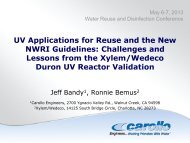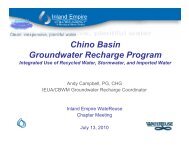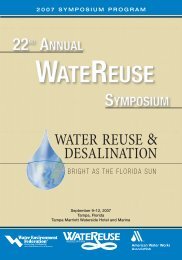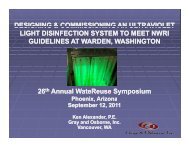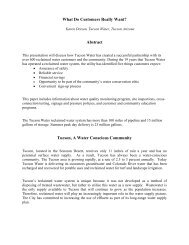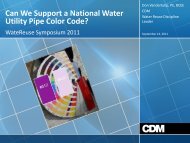Titanium Oxalate
Titanium Oxalate
Titanium Oxalate
Create successful ePaper yourself
Turn your PDF publications into a flip-book with our unique Google optimized e-Paper software.
A Simple Spectrophotometric Method forthe Detection of Hydrogen PeroxidePhil Brandhuber, Ph.DHDR Engineering, DenverGregory Korshin, Ph.DUniversity of Washington
Peroxide Detection• WRF project to evaluate chemical detectionmethods for peroxide residual• Project objective:“to develop/evaluate a laboratory method forreliable quantification of hydrogen peroxide in 0.5– 5 mg/L concentration range that is effective in anatural water matrix as well as in the presence ofcombined chlorine (chloramine)”
Project Approach• Literature review- Expert recommendation• Bench evaluation- University of Washington (UW)• Interlaboratory evaluation- West Basin, OCWD
Literature Review – Expert Panel• Objective- Review existing methods- Select methods for additional evaluation
Peroxide DetectionMethods Describedin Literature
Summary of Literature Review/Expert Panel• Literature review- Identified 13 methods• Evaluation Criteria- Probable effectiveness- Suitable detection level- Simplicity• Expert recommendation for bench evaluation- Copper/DMP- <strong>Titanium</strong> oxalate
Bench Level Testing at UW• Objective- Evaluate method sensitivity to combined chorine- Establish MDL, precision and bias- Modify/develop method
Absorbance Spectra of 2,9-dimethyl-1,10-phenanthroline/copper (Cu/DMP)Cu/DMPmethod is verysensitive toH 2 O 2
Calibration Data at Various Known ChloramineConcentrations – Cu/DMPBut chloramineinterferes withthe method
Absorbance Spectra of <strong>Titanium</strong> <strong>Oxalate</strong><strong>Titanium</strong> oxalatemethod is lesssensitive to H 2 O 2
Calibration Data at Various Known ChloramineConcentrations – <strong>Titanium</strong> <strong>Oxalate</strong>But chloraminedoes notinterfere withthe method
<strong>Titanium</strong> <strong>Oxalate</strong> Method MDL, Precision, Bias
<strong>Titanium</strong> <strong>Oxalate</strong> Peroxide DetectionMethodologyStep 1 - Prepare Reagents- 0.1 N potassium permanganate solution- 50 g/L potassium titanium oxalate solution- (1+9) sulfuric acid solution- (1+17) sulfuric acid solution- 1000 mg/L hydrogen peroxide solutionStep 2 - Standardize hydrogenperoxide solution- Titrate with potassiumpermanganateStep 4 - Prepare Samples forAnalysis- Pipette sample, mix withtitanium oxalate/sulfuric acidsolutionStep 3 - Develop CalibrationCurve- Develop best fit line relatingoptical density (measured byspectrophotometer) to sixperoxide standardsStep 5 - Determine PeroxideConcentration- Obtain optical density ofsample- Calculate peroxideconcentration from calibrationcurve
<strong>Titanium</strong> <strong>Oxalate</strong> Peroxide DetectionMethodologyStep 1 - Prepare Reagents- 0.1 N potassium permanganate solution- 50 g/L potassium titanium oxalate solution- (1+9) sulfuric acid solution- (1+17) sulfuric acid solution- 1000 mg/L hydrogen peroxide solutionStep 2 - Standardize hydrogenperoxide solution- Titrate with potassiumpermanganateStep 3 - Develop CalibrationCurve- Develop best fit line relatingoptical density (measured byspectrophotometer) to sixperoxide standardsStep 4 - Prepare Samples forAnalysis- Pipette sample, mix withtitanium oxalate/sulfuric acidsolutionStep 5 - Determine PeroxideConcentration- Obtain optical density ofsample- Calculate peroxideconcentration from calibrationcurveSample prep• 10 ml sample• 1 ml (1+17) H 2 SO 4solution• 1 ml titanium oxalatesolution (50 g/L)• Dilute to 25 ml with DI• 5 minute colordevelopment• Absorbance ay 390nm using 10 mm cell
Summary of Bench Level Testing at UW• Copper/DMP method more sensitive(absorbance) to peroxide than titanium oxalate- But subject to interference to presence of chloramine• <strong>Titanium</strong> oxalate method not impacted bychloramine• <strong>Titanium</strong> oxalate sufficiently sensitive andaccurate for this application
Interlaboratory Testing• Objective- Evaluate method performance in the field• Between labs• Between water sources• Between sample locations
Interlab Study Design: n= 72 Samples• 3 x 3 matrix of known additions• Peroxide (0, 2.5, 5.0 mg/L), chloramine (0, 1, 2 mg/L)• Two waters• OCWD• West Basin• Two sample locations• Upstream, downstream peroxide addition• Two labs• OCWD• West Basin
Comparison of Split Samples Analyzed by West Basinand Orange County LaboratoriesWest Basin Lab returnedslightly lower peroxideconcentration thanOrange County Lab forsplit samplesResults statisticallysignificant at 95%confidence level
Comparison of Equally Spiked Orange County andWest Basin Water SamplesWest Basin waterreturned slightly lowerperoxide concentrationthan Orange Countywater for equallyspiked samplesResults not statisticallysignificant at 95%confidence level
Comparison of Equally Spiked Upstream andDownstream SamplesDownstream waterreturned slightly lowerperoxide concentrationthan upstream water forequally spiked samplesResults statisticallysignificant at 95%confidence level
Two-way ANOVA Relating Possible Sources ofVariation and Measurement Error
Summary of Interlab Study Results• Two tailed t-test analysis- Between labs- Between waters- Between locations• Two way ANOVA- Peroxide concentration andmeasurement error- Chloramine concentration andmeasurement error- Combined peroxide andchloramine concentration andmeasurement error• Finding- West Basin < OC- No difference- Down stream < up stream• Finding- No impact- No impact- No impact
Project Summary• Reviewed methods in literature- Selected two methods for additional evaluation• Bench level evaluation of titanium oxalate andCu/DMP method- <strong>Titanium</strong> oxalate method not impacted by combinedchlorine• Interlab evaluation of titanium oxalate method- Good agreement between labs• Final report is available from WateReuse Foundation
Thanks to:• Sponsor- WaterResearch Foundation- West Basin WD- Orange County Water District• Folks involved- Uzi Daniel- Josh Dickinson- Caroline Sherony- Steve Fitzsimmons- Gregg Oelker
Thanks for Your Timephilip.brandhuber@hdrinc.com




